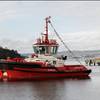CWind Orders Hybrid Crew Transfer Vessel
Isle of Wight shipbuilder Wight Shipyard Co (WSC) has been contracted by CWind to build the world’s first hybrid surface effect crew transfer vessel, to service the Borssele 1 and 2 offshore windfarms located 23 kilometers off the Dutch coast.
CWind’s long-term charter contract agreement with Ørsted, which operates the Borssele 1 and 2 offshore windfarms, will start in mid-2020. The agreement will cover an initial three-year firm charter with options available for a further two years.
WSC said it will manage the build project from its development stage right through to delivery. The vessel will be able to handle 2m significant wave height during technician transfer in heavy seas. At the same time, it will decrease fuel consumption and CO2 emissions.
The Hybrid SES propulsion engine will deliver sprint speed and extreme bollard push from its 1,600 kW installed diesel engines, which can be battery boosted up to 1,500 kW.
Significant fuel savings will be achieved through balancing engine and inefficient low engine power running hours, with battery drive modes including windfarm standby and low speed/harbor operations. This will lead to an engine operating hour reduction of 50% during windfarm battery standby.
Corvus Energy said it has signed a contract with SEC Marine Ltd, UK to supply the energy storage system (ESS) for the newbuild.
Martyn Drye, Director of Engineering at CWind said, “We embarked on the design of this revolutionary project last year, which utilities new technology to meet industry drivers for improved performance and reductions in carbon emissions. We’re proud to be delivering a concept which is at the forefront of CTV innovation and look forward to a collaborative working partnership with Wight Shipyard Co over the coming months for the build of this vessel.”
The Hybrid SES crew transfer vessel, with 24 passenger capacity, was developed in partnership with CWind and ESNA, a ship design company based in Kristiansand, Norway, which specializes in commercially competitive vessels with surface effect technology to deliver significant carbon reductions.
Consisting of two catamaran hulls with the area between the hulls closed, by flexible reinforced rubber fingers in the bow and an inflated rubber bag in the stern. Centrifugal fans blow air into this enclosed space, providing an air cushion that supports up to 80% of the vessel weight.
The remaining 20% is supported by hull buoyancy. This allows for higher vessel speed because the hull resistance is significantly decreased. It also reduces motion owing to less wave contact. In addition, the air cushion acts as a large shock absorber, improving the seakeeping and reducing seasickness.
Naval architect and co-founder of ESNA, Trygve H. Espeland, said, “We see that hybrid propulsion in vessels like offshore wind crew transfer vessels enables a greener footprint and multiple benefits for the vessel owners. The vessels have the benefit of range with the combustion engine, while the batteries provide both increased speed with power boost, peak shaving and reduced fuel consumption. Moreover, the engines will have fewer running hours and the silent hours on board will be appreciated by the crew and passengers.” He adds, “The vessel design will accommodate further developments in hybrid propulsion and battery technology, ensuring it has the capability of being developed into a totally carbon-free solution in the future.”
“We have built a reputation in the fast ferry arena and commercial marine sector,” said Peter Morton, CEO WSC. “But this a world first, building a hybrid SES for crew transfer. Building greener vessels has been an integral focus for some time now so we are well placed to lead this step change in Crew Transfer Vessels.”
The new CWind Hybrid SES will enable Ørsted to not only deliver and service windfarms efficiently through reduced transit times, but support Ørsted’s green energy ambition.
Kim Klokkervold, Senior Sales Manager at Corvus Energy is clear in his predictions: “The electrification of crew transfer boats and smaller workboats has only just begun. We are confident that we will see a massive shift from diesel to battery-hybrid powered propulsion on all kinds of smaller workboats due to substantial benefits and increased focus on reducing emissions.”
The lightweight Corvus Energy Dolphin modules are suited to crew transfer vessels as they are tailormade for weight-sensitive vessels and have multiple possibilities of installation which ensures the optimal hybrid solution for maximum emission savings. Moreover, batteries are safer and quieter for the crew, and save both fuel and maintenance costs for the owners.













